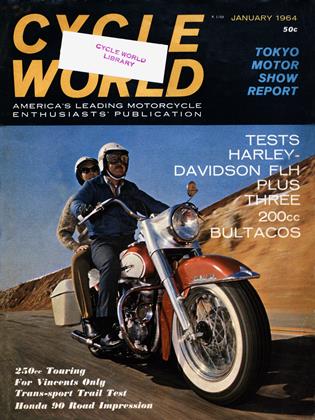HONDA 90
Road Impression
WHAT'S IT LIKE TO RIDE the Honda 90? Well, it’s a little like riding a big Honda 50, which is just about as accurate a description of the 90 as we can devise. Bore and stroke are 49mm x 46mm, power is 6.5 @ 8,000 rpm. Its predecessor, the fifty, developed 5.0 hp @ 9,500; that extra 1 1/2 horsepower is one of the first things the 90 rider is going to like. It didn’t hurt a bit to add the extra power. Performance is bettered, up to 55 miles per hour, and flexibility is improved. Acceleration from 25 mph to top speed is increased with the larger displacement, a safety factor not to be slighted. Improvement through the entire torque range will find acceptance among riders of the 50 desiring a little more push.
Honda’s 90, or C-200 as it is denoted, is obviously based on the Honda 110, not the “fifty” we see in all the slick magazines, though the 50 and 110 share the same engine. The major difference is the three-speed gearbox with a conventional clutch in place of the 50’s centrifugal, or automatic, clutch. In other words, the 50cc C-110 is more of a true motorcycle. A conventional backbone type frame, tank mounting and other such features separate the 110 from the 50 also, but the most important is the gearbox and clutch.
Honda sells lots of small cycles, or twowheel compacts as they call them, on the basis that they are fun. Personally, we think that description pretty well fits all motorcycles; even so, we have to agree with them, the Honda 50, or 90, is indeed fun.
Handling is quick and positive, brakes are adequate for the job at hand and the ride is comfortable, though we would like the seat to be a bit wider (or our derrières a little narrower). Performance, though not exactly shattering, is quite amazing considering how small the engine is. Several spirited trips through traffic endeared us to the little machine; it is quiet, subdued, smooth and altogether satisfying.
A discussion should not exclude the price, low enough to make the lowest form of hieh-pressure salesman look like your fairy Godmother. Dealers should be grateful, for thev hardly need sell this one; more than likely they will have to fight the takers off.
As with the C-110, the C-200 is not equipped with electric starting, a luxury it suffers not one whit without. Breathe there a man not capable of flicking the five plus cubic inch engine to life, and he shouldn’t be riding. As for the ladies riding them, we haven’t found one yet who couldn’t start anything in this category. What’s more, they seem to enioy them as much as any of CYCLE WORLD’S staff, perhaps more, considering what a jaded bunch of throttle twisters we are.
Perhaps we sound a bit flippant. Talking about this Honda is a little like interviewing a teenage movie star, particularly since Honda won’t even call it a motorcycle. But motorcycle it is, and as such we respect it. Previous experience with a C-110 Honda converted for trail use (CYCLE WORLD October 1963 issue), demonstrated the potential versatility of the bike, but it is more at home on the pavement.
We predict success for the newest member of the Honda family, thanks again to that same twist of the licensing laws in its native Japan that allow youths the use of machines up to 90cc displacement, practically wiping out the 50cc market in Japan. We are certain Honda will continue to push the fifties over here since they really don’t need the additional displacement, but put it to excellent use. •












